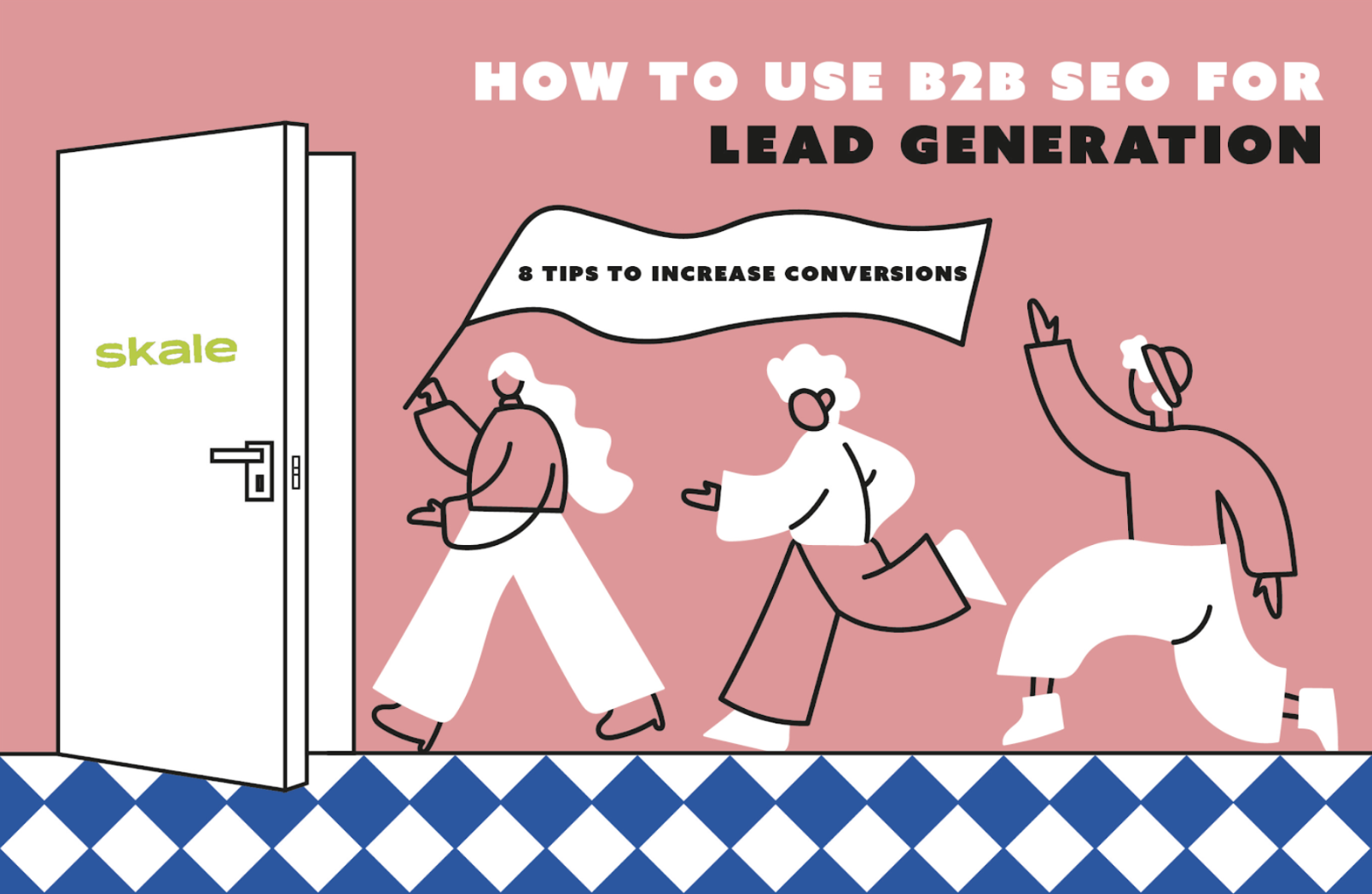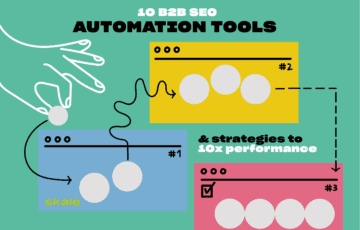
The Power of Partnership: 7 Benefits of Hiring a B2B SEO Agency
These benefits of hiring a B2B SEO agency illustrate why outsourcing your content can help you to drive new revenue for your business.

Every business owner wants to have a steady stream of qualified sales leads. You need an effective lead generation strategy to get there. Most importantly, you need a B2B strategy that gets you qualified leads, moves them down the funnel, and converts them into paying customers.
All that happens faster when you get search intent right and rank on Google search results. In other words, when using SEO for lead gen.
SEO for lead generation is the art of drawing in visitors and potential customers who use search engines, like Google, to look for products and services you sell. It’s also the delicate art of learning from your potential customers so you can keep delivering exactly what they need to go from potential to actual paying customers.
If you’re struggling to get there, this article walks you through eight actionable tips to increase conversion and get the most out of your B2B search marketing.
SEO lead generation uses search engine optimization tactics to rank higher on search engine results and attract qualified leads, which are ready to spend money on your products or services.
The question is: how do SEO and lead generation work together?
Whenever you turn to Google to buy something, you typically use search queries with relevant words like ‘buy,’ ‘purchase,’ or ‘services’ in the search box. The relevant product pages and other results ranking for those transactional keywords appear.
Investing in SEO helps your web pages appear on SERPs for those queries. After coming across your website for relevant search queries, users start interacting with your brand to weigh their options.
68% of online experiences begin with a search engine query. If you do SEO right, Google will recommend your website over and over. Once people gain trust in you, you’ll see the real magic–more traffic, sales, revenue, and business growth.
Additionally, sometimes it can be hard to untangle your SQLs, or Sales Qualified Leads, from your MQLs, or Marketing Qualified Leads, however, SEO can truly help you improve your SQL–and revenue–numbers simply by how they get to your content and how you are presenting it to them.
SEO works well for lead generation because it helps you appear before your target audience, and get more relevant traffic, and more paying customers.
There are also some important metrics to look at that can really tell you if your marketing and SEO are going in the right direction. Worry not, we’ll cover the most important ones here.
Let’s first take a closer look at why SEO is so important for lead generation.
B2B sales cycles are longer with more people in the decision-making process, so the right SEO strategy is crucial for B2B businesses looking to attract high-intent web traffic that converts into leads.
As these decision-makers conduct thorough research, your products and services must appear high on search results for different related queries. By increasing your brand visibility, you will be top of mind when B2B decision-makers consider purchasing the product or service you offer. You’ll see more qualified leads, engagement, and conversion as you scale lead generation.
Still, trying to decide whether to invest in B2B SEO? Check out these benefits and see how SEO pays off over time:
“There are two main benefits to using SEO for lead generation. First, it’s mostly evergreen—you can make the investment upfront, and continue to reap benefits for years. Second, if you’re smart about your topic selection, it tends to bring you users who are highly qualified, because they went to Google for help solving some particular problem. It’s a highly motivated, active audience—not an audience that you’re grabbing while they happen to, say, check their email to open up Instagram.”
–Lucia Tang, Head of Content @ Keeper
Some B2B shoppers will need the extra push to seal the deal. They may be at the final stage of the sales funnel but are yet to be ready to convert as they have unanswered questions. These customers are going back to Google, and other search engines, to look up your trustworthiness.
That’s why your SEO marketing strategy should also focus on creating case studies, thought leadership content, or generating customer reviews that position you as a leader in your domain. All with the purpose of guiding your users and readers to your helpful resources so that they can click the ‘Chat with us!’ button in a heartbeat–or even better the ‘Get starter’ one.
By now you might be wondering, if the goal is to appear on search engine result pages, what’s the difference between SEO and PPC?
We’re glad you asked.
The key difference between SEO and pay-per-click (PPC) is that SEO helps your brand gain visibility for informational and commercial queries, whereas PPC involves running paid search ads for converting potential customers.
What do SEO and PPC do precisely?
Following SEO best practices helps you optimize your website and have better chances of ranking on search engines–organically. These optimizations include:
PPC is an online advertising technique that helps you serve laser-targeted ads on search engines and social media. You pay a fee every time a visitor clicks on your ad.
Setting up PPC advertisements involves:
Both SEO and PPC have some advantages and disadvantages.
Let’s look at PPC first.
Efficient PPC ad campaigns with solid landing pages and the right keywords will get you instant results. You can also target different geographics, and demographics, and run A/B tests to understand what’s performing better.
However, PPC can quickly get expensive because everyone wants to target and bid on the same keyword. Additionally, you’ll need to constantly monitor existing ads and refresh them for maximizing revenue.
SEO strategies may take longer to produce results, but these are long-lasting results that aim to keep growing your online presence.
With SEO you initially spend a lot of time and money creating competitive and educational content that informs buyers and builds website authority. Slowly but surely, potential customers will start seeing you as a credible, trustworthy industry expert. That’s when you start ranking for targeted keywords, drive traffic, get leads, and drive them through the sales funnel–all organically achieved.
“The main benefit of SEO in the case of lead generation is its long-lasting effects. Unlike paid strategies such as PPC advertising, the results of SEO efforts can continue to drive leads for your business even after the initial work has been completed. Obviously, you have to work with SEO, i.e., update content and address algorithm changes, to maintain and improve your rankings, but the initial investment can pay off for a long time.”
–Natalia Brzezinska, Marketing & Outreach Manager @ PhotoAiD
PPC results disappear almost the moment you stop paying, instead, SEO results last for some time after that, but will start to diminish as time goes on if you don’t keep investing in SEO.
The image above shows how Skale organically ranks for the keyword SaaS SEO agency. The ads you see above it will keep changing depending on who wins the PPC bidding war. However, the organic result will only solidify its position over time.
Here’s a final stat that will prove to you why SEO is a must, and PPC might not be the right investment to do: 58% of people don’t trust the ads they see online. Everyone is Google-ing their questions, but most are looking for the organic results, not the ads section.
If that has got you thinking, check out these actionable tips on generating leads with SEO.
Generating SEO leads starts with putting the right strategies to use. Using SEO for lead generation can be incredibly simple:
How do you get started? This section outlines eight strategies that you can start leveraging today.
A detailed website audit tells you what’s affecting your search rankings and overall performance. In your audit, you’re looking for every single factor that’s helping or stopping, you from achieving visibility in search engines.
There are several different types of audits:
All these may seem a little overwhelming. Luckily, there are plenty of B2B SEO tools today that can help you with website audits. After you run an audit, you’ll be able to diagnose and resolve:
Tools are absolutely crucial for website auditing, but you also need a team of experts to help you make the most out of them and succeed.
A simple website audit using a tool like Ahrefs shows top issues along with keywords you rank for, organic traffic, backlinks, and more.
You can then dive deep into these issues and affected URLs. Fixing these audit issues will help you improve the overall domain health, domain rating (DR), organic traffic, and more. Also, remember to look at Google Analytics and Google Search Console as well to track different performance metrics and issues.
Keyword research is key to understanding what queries people use to look for products and services. Analyzing these keywords, their intent, and search volume will enable you to create content that satisfies both users and search engines.
Researching keywords helps you:
How do you go about researching keywords? Start by finding broad topics relevant to your business and customers. Then use a keyword research tool to find relevant phrases that can help you rank on search engines for that topic.
Coupling the right keywords with the right search intent is the winning combo. Instead of taking keywords at face value, spend some time understanding the search intent of each keyword. Search intent analysis tells you the reason behind an online search.
The four types of search intent are:
Once you figure out the search intent behind keywords, you’ll be able to better prioritize content creation and make sure each piece of content matches the user intent behind the main keyword.
Imagine your company is launching a content management system. Here’s how you can go about keyword research for this topic.
First, you can simply plug in the keyword ‘content management system’ to the keyword tool of your choice to understand search volume, keyword difficulty, and traffic potential.
Then you can find related keywords to understand their intent, volume, and difficulty. Don’t forget to check Google autocomplete suggestions. These topics tell you what people are actually looking for.
Once you collate all the keywords, you can prioritize low-hanging fruits–aka high-volume keywords with low difficulty. Create content around multiple short-tail and long-tail keywords to rank faster. Long-tail keywords are phrases with low search volumes but are often used during the point of purchase.
Remember to look at Google Analytics and Google Search Console as well to track different performance metrics and issues.
Every blog you write should focus on one key theme. Optimizing each piece for a single keyword will help you satisfy the search intent and answer every related sub-topic. To get the most of your SEO efforts, make sure you’re publishing regularly.
The rate at which pages are created and published is known as content velocity–and Google really likes websites that have a constant influx of fresh content. It also helps improve your chances of being found, simply due to quantity.
Follow these best practices to optimize every blog for easy crawling and gaining visibility on search engines:
Ready to check out what an SEO-optimized blog looks like?
If you look at the Skale blog, you’ll see every content piece is optimized around a key theme.
Every blog is structured and optimized for SEO so that visitors can easily find what they came for.
Need a good SEO-optimized blog template? Check out this template from Ahrefs. It clearly shows how to structure your blog with a title, intro, headers, and conclusion for maximum impact.
Site speed matters more than you can imagine. Most people will abandon your website if a page doesn’t load quickly. In fact, 53% of visitors will leave a page if it doesn’t load in just three seconds. A fast load speed is a competitive advantage as it quickly shows shoppers what they came looking for. A report published by Google shows that improving website speed by just one second can help you increase conversions by up to 27% for mobile users.
Site speed is also an important ranking factor. Google’s Core Web Vital signals consider page experience signals in search ranking algorithms. These signals consider three user-centric metrics:
All these show the importance of improving site speed. Wondering how to improve it? Check out these tips to get started:
Let’s look at how to put all these into practice.
Use PageSpeed Insights to understand what real users are experiencing while accessing your site. Simply enter your URL and hit analyze to get started. This example shows Core Web Vitals for Amazon.com.
PageSpeed Insights show whether your site passed or failed based on Core Web Vital metrics collected over the last 28 days.
You’ll also get to see a bunch of recommendations that may help your page load faster.
Click on issues to understand them in detail and find potential solutions.
Link building is an essential part of SEO. Getting more links from other websites helps search engines find new pages on your site–if you link to those new pages–and rank them higher in search engine results. This happens because Google sees inbound links as a vote of confidence from other sites.
However, not all links are equal. A link from an authoritative site like Forbes will have more link juice–or how much power and authority a backlink passes to another domain–than a random website published last year.
Wondering if you should invest your time in getting backlinks? Let’s look at the benefits:
If you’re wondering how to build links fast, check out this extensive guide on link-building strategies.
MoonPay is a leading cryptocurrency payment platform. They were struggling to get non-brand organic clicks to their transactional pages.
With Skale’s link-building solution, they were able to secure 7K+ links per month to high-intent transactional pages. Check out the full case study to learn how Skale worked with publishing partners to acquire high-quality backlinks for MoonPay.
If you’re a small business trying to get more local customers, you should definitely zero in on a local SEO lead generation strategy. Businesses with brick-and-mortar stores use local SEO to improve search engine visibility and get more organic traffic.
Try out these local SEO tips to get more local prospects for your business.
Finally, remember to participate in local community events. These events are ideal for building brand awareness and generating leads.
Google is the first place people go when they are looking for places near them. That’s why it’s important to be present on Google My Business.
Add as many details as you can to make the most out of Google My Business. Remember to also answer FAQs and encourage satisfied customers to leave reviews.
Customer reviews are excellent trust signals for future buyers and can also improve SEO rankings. These reviews can be positive or negative. Negative reviews present opportunities for you to understand customer problems, solve them, and share results in public.
When you focus on reviews to gain brand trust, you’ll automatically increase sales from web traffic. How do you get started?
Time to see a real-life example:
Check out how Ahrefs uses a carousel of customer reviews to appeal to each customer segment they serve.
They also mention how users rated them on third-party review platforms.
Both the reviews and ratings appear just before the CTA on their homepage. These trust signals persuade buyers who are hesitating to make the purchase.
Once you’re done following all the previous steps, you’ll want to know if your efforts have been worth it.
Truth is, lead gen is just the beginning. Getting thousands of new leads without being able to guide them down the sales funnel would just be a vanity metric to show but nothing else. That’s why the final step to use SEO for lead gen is to make sure you’re not just using it for lead gen.
How can you check this?
By checking the metrics that really matter:
Increasing organic traffic is an excellent way to start but definitely not enough to build a revenue pipeline. That’s why you need a top-class content marketing and SEO strategy that drives product adoption, increases conversions, and generates recurring revenue.
You can undoubtedly leverage SEO tools to get there but you’ll also need a team of experts who know what works and doesn’t. A B2B SEO agency often has a deep understanding of the challenges you face and can help you scale customer acquisition. They are SEO-tool experts but also work with multiple clients and marketing budgets—which altogether makes them uniquely qualified for driving growth with SEO.
If you’re looking for an agile agency to gain a competitive advantage faster, book a call today to see how Skale can help you increase SEO lead generation, conversion, and overall revenue.
SEO for lead generation is the process of creating insightful content with transactional keywords that attract ready-to-buy leads and improve brand awareness organically. Unlike PPC, you don’t have to pay every time you generate these leads.
Yes. SEO leverages relevant, helpful content to help a business rank for relevant keywords. Once your website starts ranking for commercial and transactional keywords, you’ll be able to increase brand awareness and get more traffic via digital marketing channels. Once there, you can nurture these visitors and convert them into leads with the right strategy.
Lead generation and SEO are not the same but often complement each other. While SEO focuses on getting web visitors to your site, lead generation involves qualifying those potential clients and converting them into paying customers.
Learn more about
B2B SEO

The Power of Partnership: 7 Benefits of Hiring a B2B SEO Agency
These benefits of hiring a B2B SEO agency illustrate why outsourcing your content can help you to drive new revenue for your business.

15 B2B Customer Acquisition Strategies that Increase Revenue
Want to find new customers who truly value your business? We’re here to help you out with a list of the top 15 B2B customer acquisition strategies.

10 B2B SEO Automation Tools & Strategies to 10x Performance in 2024
Save time with the right B2B SEO automation tools and strategies that are sure to bring your marketing to the next level–we've listed them here.